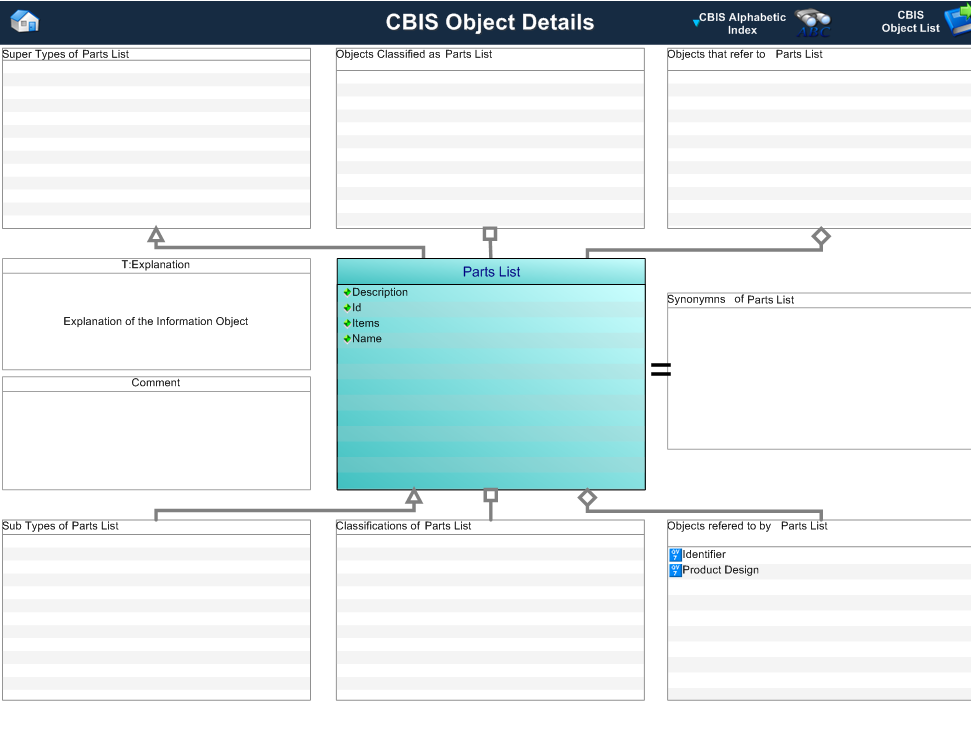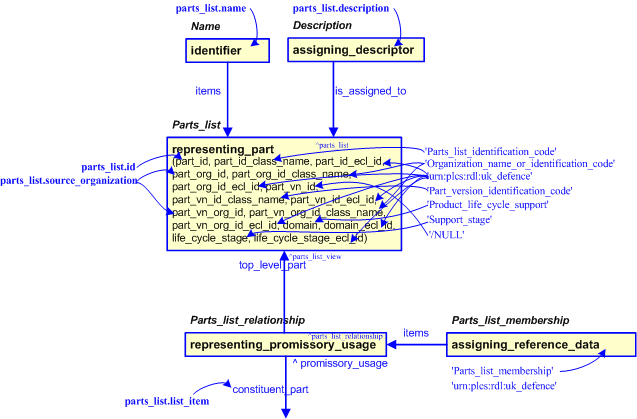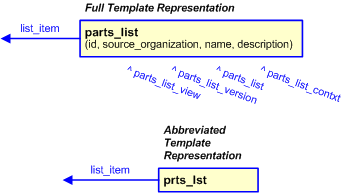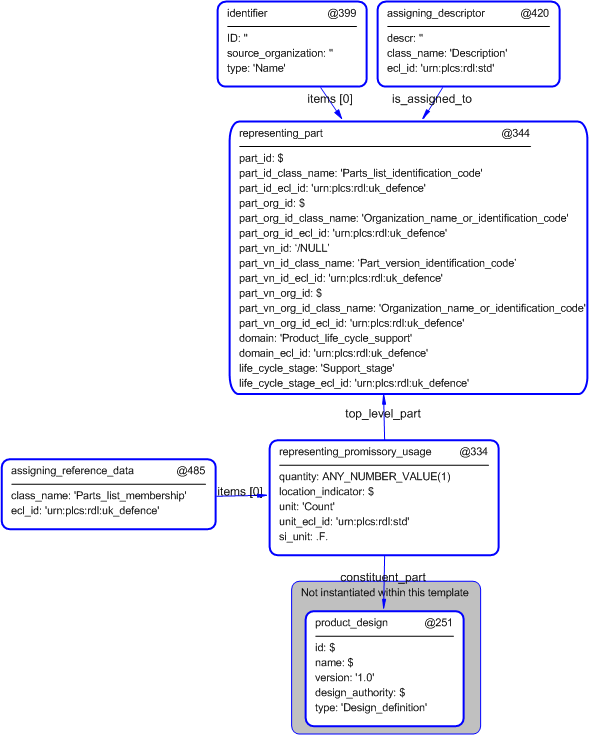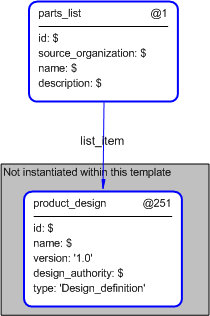Template:— parts_list (prts_lst)
Context:— UK_Defence |
Date: 2009/04/17 10:29:33
Revision: 1.7
|
This section specifies the template parts_list.
NOTE
The template has been defined in the context of
UK_Defence.
Refer to the business context for details of related templates.
NOTE
An explanation of a template and the associated instantiation path is
provided in the
Template overview
section.
This template describes how to represent list of parts.
This information object represents a list of items which can be used for the purposes of supply, or any other purpose.
Figure 1 — Graphical Representation for Business Object parts_list
The definition of a parts_list object is: a collection of Product Designs. This list could be used as a list of non-codified
items for supply, or any other general purpose.
|
Attribute name
|
Attribute description
|
Attribute type
|
Optionality
|
| Id |
This is the identifier of the parts list. |
Identifier |
Mandatory |
| Identifier.id |
This is the value of the id attribute of the Identifier applied to the parts list. |
intrinsic |
Mandatory |
| Identifier.type |
This attribute is the type associated with the id of the Identifier given to the parts list. |
Parts_list_identification_code |
Mandatory |
| Identifier.source_organization |
This attribute is the value representing the source organization that provides the id of the Identifier given to the parts
list. This value is assumed to be a type of Organization_identification_code.
|
Organization_name_or_identification_code |
Mandatory |
| Items |
This is a reference to the parts (product design) in the list. |
Relationship to Product_design |
Mandatory (1:?) |
| Name |
This is the name of the parts list. |
intrinsic |
Mandatory |
| Description |
This is the description of the parts list. |
intrinsic |
Mandatory |
Table 1 — parts_list attribute details
The EXPRESS-G diagram in
Figure
2
shows the templates and EXPRESS entities that are required
to represent the template
"parts_list".
The text highlighted in blue shows the template parameters.
Figure 2 — An EXPRESS-G representation of the Information model for parts_list
The graphic for the template to be used in other EXPRESS-G diagrams
is shown in Figure
3
below.
Figure 3 — The graphical representation of the parts_list template
The following input parameters are defined for this template:
This is the identifier of the parts list.
The organization or information system that created the associated identifier. Alternatively this could be set to /NULL when
Person or Information System is the source; see Identifier template characterizations.
This is the name of the parts list.
This is a description of the parts list.
The related list item. Note a new instance of this template is required to relate more than one item at a time.
The following reference parameters are defined for this template:
Allow the
Part_view_definition
entity instantiated in this path to be referenced when this template is used.
%^target = $parts_list.parts_list_view%
This reference parameter provides a reference to the view definition that represents the head (or top) of the list itself.
All items in the list are related using an instance of promissory_usage relationship. There is one relationship for each item.
Allow the
Part_version
entity instantiated in this path to be referenced when this template is used.
Note: The
Part_version
entity can be referenced in a template path by:
%^target = $parts_list.parts_list_version%
where
target
is the parameter to which the
Part_version
is bound.
This reference parameter provides a reference to the Part_version that represents the head (or top) of the list itself. There
is one version for each view definition.
Allow the
Part
entity instantiated in this path to be referenced when this template is used.
Note: The
Part
entity can be referenced in a template path by:
%^target = $parts_list.parts_list%
where
target
is the parameter to which the
Part
is bound.
This reference parameter provides a reference to the Part that represents the head (or top) of the list itself. There is one
part for each version.
%^target = $parts_list.parts_list_contxt%
This reference parameter provides a reference to the Part that represents the head (or top) of the list itself. There is one
part for each version.
The following parameter combinations specify a uniqueness constraint:
Unique constraint: Parts_list_id_rule
Each instance of the
entity
(
Part)
within the data set shall be uniquely identified
by a combination of the following parameters on this
template (parts_list) namely:
id,
name,
source_organization.
The
instance is
referenced by the following template parameter:
parts_list.
The instantiation path shown below specifies the entities that are to be
instantiated by the template.
A description of templates and the syntax for the instantiation path is
provided in the
Templates Help/Information section.
-- Create the Promissory_usage entity /
representing_promissory_usage(
quantity=1)/
%^parts_list_relationship = $representing_promissory_usage.promissory_usage%
/
assigning_reference_data(
class_name='Parts_list_membership',
ecl_id='urn:plcs:rdl:uk_defence',
items=^parts_list_relationship)/
-- Create the part to represent the head/top of the list /
representing_part(
part_id=@id,
part_id_class_name='Parts_list_identification_code',
part_id_ecl_id='urn:plcs:rdl:uk_defence',
part_org_id=@source_organization,
part_org_id_class_name='Organization_name_or_identification_code',
part_org_id_ecl_id='urn:plcs:rdl:uk_defence',
part_vn_id='/NULL',
part_vn_id_class_name='Part_version_identification_code',
part_vn_id_ecl_id='urn:plcs:rdl:uk_defence',
part_vn_org_id=@source_organization,
part_vn_org_id_class_name='Organization_name_or_identification_code',
part_vn_org_id_ecl_id='urn:plcs:rdl:uk_defence',
domain='Product_life_cycle_support',
domain_ecl_id='urn:plcs:rdl:uk_defence',
life_cycle_stage='support_stage',
life_cycle_stage_ecl_id='urn:plcs:rdl:uk_defence')/
-- re-direct the output from the call %^parts_list = $representing_part.part%
%^parts_list_version = $representing_part.version%
%^parts_list_view = $representing_part.view%
%^parts_list_contxt = $representing_part.contxt%
-- Name /
identifier(
ID=@name,
source_organization=@source_organization,
type='Name',
items=^parts_list)/
/
assigning_descriptor(
descr=@description,
class_name='Description',
ecl_id='urn:plcs:rdl:uk_defence',
is_assigned_to=^parts_list)/
-- Map the input parameters to those for rep_prom_usg, first is the top item
^parts_list_relationship.related_view ->
@list_item
^parts_list_relationship.relating_view ->
^parts_list_view
The instance diagram in Figure
4
shows an example of the EXPRESS entities and templates that are instantiated by the template:
/parts_list(id='', source_organization='', name='', description='', list_item='@251')/
(an illustration of the consolidated parts_list template is shown in
Figure
5 below.)
Figure 4 — Entities instantiated by parts_list template
The instance diagram in
Figure
5
shows the graphic symbol for the template that is to be
used in other instance diagrams. The example template is:
/parts_list(id='', source_organization='', name='', description='', list_item='@251')/
Figure 5 — Instantiation of parts_list template
Characterizations
No common characterizations of the template
parts_list
have been identified. However, the ISO 10303-239 EXPRESS model
may enable other assignments to the entities instantiated by the template.
